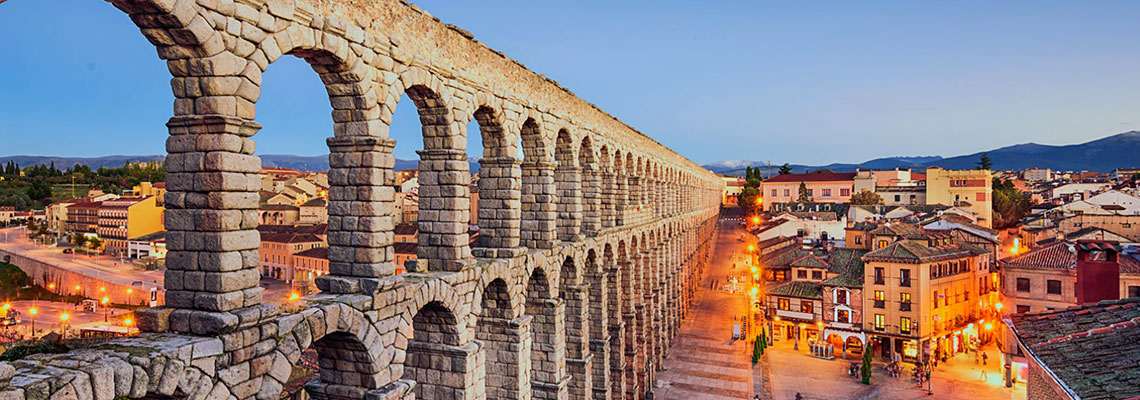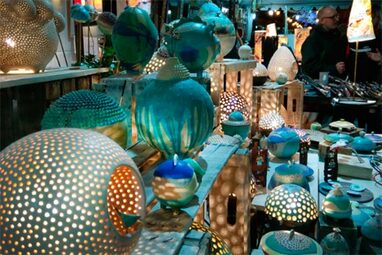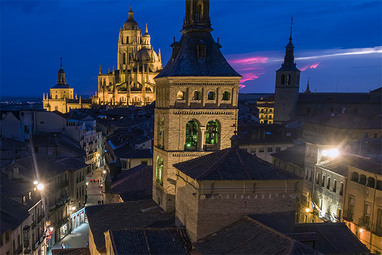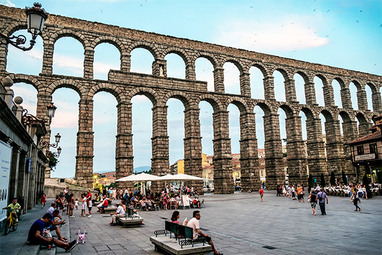
Segovia
Segovia
THE CITY

Segovia lies a thousand metres above sea level with the Sierra de Guadarrama mountains nearby, and its historical city centre sits on a rocky outcrop balancing between the gullies carved out by the Rivers Eresma and Clamores. Its emblematic Aqueduct and Alcazar are just part of its historical character.
In Segovia, Alfonso X studied the night skies, Quevedo took inspiration from its spaces and its people to write El Buscón Don Pablos. This is where Isabel I the Catholic was proclaimed Queen of Castile and here the first book was printed in Spain, El Sinodal de Aguilafuente. Its people and its cultural traditions survive the passing of time and its gastronomy of lamb and sucking pig complete the experience in this city.
ARTISAN TRADITIONS

In this ancient city of trades, ceramics, pottery and enamel work in very different designs, from the most traditional to the most innovative, are still found: Renaissance carvings and other work in wood, artisan tapestries and embroidery, modelling in tin, embossed metal work and wrought iron, etc.
ESSENTIALS

Segovia, declared a World Heritage Site in 1985, welcomes you to the city with its Aqueduct, one of the most superb constructions left by the Romans anywhere in their vast empire. It was built to bring water from the mountains to the city of Segovia –legend attributes its construction to the Devil himself- and it is the heraldic symbol of the city. Its 167 arches, made of granite from Guadarrama, are constructed from shaped blocks of stone without any kind of cement, held up through the ingenious equilibrium of forces. An extraordinary work, it served the city until recent times.
After passing through the Aqueduct, your historical walk through Segovia will take you to the main square, Plaza Mayor, framed by the pinnacles of the late Gothic apse of the Cathedral, an evening meeting point for storks.
At this point of the route, you will have noticed the walls surrounding the city, whose perimeter is over 3,000 metres. These walls begin and end at the Alcazar, another can’t-miss visit.
See its profile and its resemblance to a ship above the gorge at the confluence of the Rivers Eresma and Clamores. Before it, there are some beautiful gardens with a monument to Daoiz and Velarde, heroes of the War of Independence. A deep moat with a drawbridge leads to a fortress situated on a prime position, possibly inhabited since Celtic times but which was built up especially during the reign of Alfonso XII. But it is the human factor which makes visitors feel more comfortable in the city as they get to know the people.
GET MOVIN!

The train is one of the quickest and easiest ways of getting to the city. From Madrid, there are several high-speed train services to Segovia, taking only 25 minutes. Once there, the Segovia Tourist Office offers you guided city tours by prior reservation.
ALTERNATIVES

Take advantage of your visit to Segovia to enjoy its culture. The city has several interesting museums and permanent exhibition halls. But, at different times of the year, the streets and plazas of the city become the stage for varied artistic activities. If you plan your visit for Easter, you will be able to discover how the interior of the churches become impressive backdrops for concerts that will delight lovers of religious music. Another event that now forms part of Segovian tradition is Titirimundi, which fills the city with puppets and marionettes. For its part, Folksegovia has become a showcase for world music. It is a very special sensation to hear, in a very short space of time, African rhythms or nostalgic Scottish music beside the Roman stones of San Juan de los Caballeros.
There are also palace patios, convent cloisters and remarkable facades which serve as the stage for many different events, such as the Chamber Music Week, the Youth Festival and the open Festival of Theatre, Music and Dance.
The night is the perfect time to stroll through the city streets, mix in with the locals and discover the traditional Castilian taverns, ideal to enjoy a tapa, where every different kind of atmosphere can be found.
FLAVOURS

In the city, you will find famous mesones and restaurants where you can enjoy the specialities of Segovian cuisine. The flagship dish in Segovia is the roast meat, especially the sucking pig and lamb, which will delight your palate with the exquisite, tender flavours of these typical meats. You can also enjoy other distinctive dishes from the region, such as sopa castellana (a soup made with bread, garlic and eggs), judiones de la Granja (a large runner bean from nearby La Granja), stews and trout. Savour the local cured sausages and wines. And if you want to sweeten your visit to the city even more, try the popular ponche segoviano (a cake with marzipan and cream) or the florones (flower-shaped fritters), torta cakes and rosquilla doughnuts.
DON’T MISS

In your stroll through the city, you can enjoy two activities in perfect harmony: sightseeing and leisurely shopping. This is possible thanks to the peculiar street pattern in the city, with the shopping areas coinciding, almost entirely, with tourist itineraries. As in all cities with a mediaeval layout, commerce is concentrated around the main square, Plaza Mayor, and from there it stretches outwards, following the evolution of the growth of the city.






